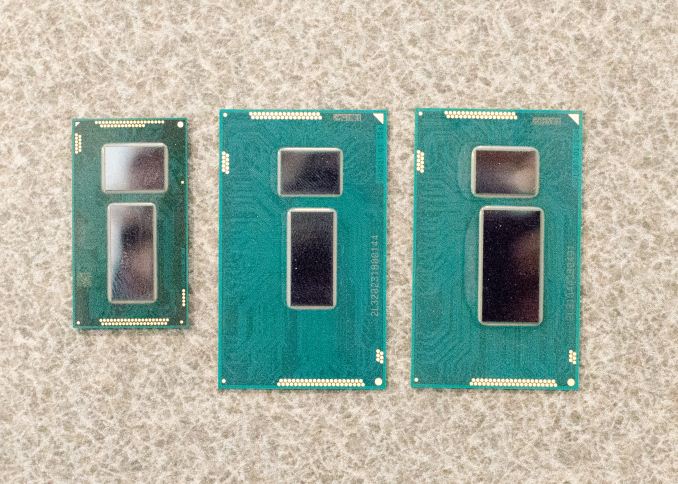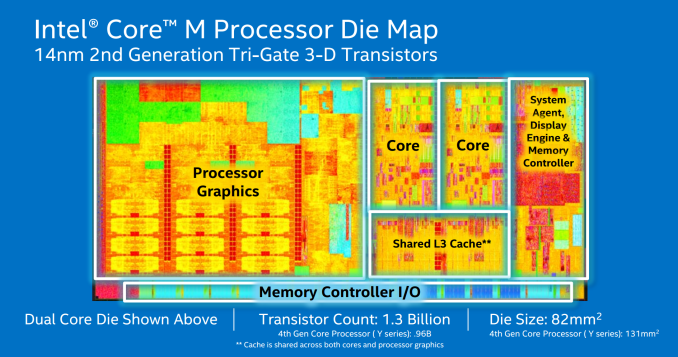More Intel Core M Coming Q4
by Ian Cutress on November 3, 2014 11:30 AM EST
Since Computex, there has been a lot of talk around Intel’s Broadwell-Y / Core-M CPU line. In August Intel treated us to a breakdown of the 14nm process and the Broadwell architecture including all the improvements therein, followed by a more succinct breakdown of the CPUs we should expect. These initial CPUs should be properly available to the public in Q4 in devices such as the Lenovo Yoga 3 Pro using the Core M-5Y70.
The news this week revolves around more Core M CPUs being pushed through the system. This is most likely as a result of Intel binning the CPUs in sufficient quantities to satisfy customers. The specifications are available at ark.intel.com, but the Core M line now stands at seven different SKUs:
| Intel Core M Specifications | |||||||
| 5Y71 (New) |
5Y70 | 5Y51 (New) |
5Y31 (New) |
5Y10c (New) |
5Y10a | 5Y10 | |
| Cores / Threads | 2 / 4 | 2 / 4 | 2 / 4 | 2 / 4 | 2 / 4 | 2 / 4 | 2 / 4 |
| Base Frequency / MHz | 1200 | 1100 | 1100 | 900 | 800 | 800 | 800 |
| Turbo Frequency / MHz | 2900 | 2600 | 2600 | 2400 | 2000 | 2000 | 2000 |
| Processor Graphics | HD 5300 | HD 5300 | HD 5300 | HD 5300 | HD 5300 |
HD 5300 |
HD 5300 |
| IGP Base Frequency / MHz | 300 | 100 | 300 | 300 | 300 | 100 | 100 |
| IGP Turbo Frequency / MHz | 900 | 850 | 900 | 850 | 800 | 800 | 800 |
| L3 Cache | 4 MB | 4 MB | 4 MB | 4 MB | 4 MB | 4 MB | 4 MB |
| TDP | 4.5 W | 4.5 W | 4.5 W | 4.5 W | 4.5 W | 4.5 W | 4.5 W |
| LPDDR3/DDR3L Support |
1600 MHz | 1600 MHz | 1600 MHz | 1600 MHz | 1600 MHz | 1600 MHz | 1600 MHz |
| Intel vPro | Yes | Yes | No | No | No | No | No |
| Intel TXT | Yes | Yes | No | No | No | No | No |
| Intel VT-d/VT-x | Yes | Yes | Yes | Yes | Yes | Yes | Yes |
| Intel AES-NI | Yes | Yes | Yes | Yes | Yes | Yes | Yes |
The new high end model is the 5Y71, offering a 2.9 GHz frequency mode and vPro features. The 5Y51 has slightly better specifications than the higher numbered 5Y70, but loses vPro compatibility. Both the 5Y31 and 5Y51 fill in the large gap between the 5Y10a and 5Y70 in the initial launch. All four new processors all have an improved base GPU frequency, up to 300 MHz, and are slated to work at a cTDP Up of 6W or cTDP Down of 3.5W, depending on the customer’s needs.
All new CPUs are slated for a Q4 launch, which would mean that they might become available for end users in products on the shelf sometime in Q1 2015.
Source: CPU-World











42 Comments
View All Comments
Walkop - Tuesday, November 4, 2014 - link
Not really. The Surface Pro 3 display uses under 4w at max brightness (yes, it's very efficient (uses less power than the 9.7" iPad Air at equivalent brightness levels).SoC is definitely the biggest draw. Batteries are the issue, now.
Walkop - Tuesday, November 4, 2014 - link
(Meant to reply here)Not really. The Surface Pro 3 display uses under 4w at max brightness (yes, it's very efficient (uses less power than the 9.7" iPad Air at equivalent brightness levels).
SoC is definitely the biggest draw. Batteries are the issue, now.
kpb321 - Monday, November 3, 2014 - link
Off hand I'd consider raising the minimum GPU speed a slight regression/downgrade rather than an improvement? I assume the old versions could run their GPU at 300mhz if they needed to and running at 100mhz when possible should take less power so having a min of 300mhz should be a slight increase in power consumptions in certain situations. It's possible that Intel found that the GPU never really got down to those speeds or it doesn't really use any more power than 100% but I'd guess it was done to make the binning easier to get the higher cpu/gpu boosts.Meaker10 - Tuesday, November 4, 2014 - link
Just like a 2.6ghz base i7 will idle below that so will the gpu in this.dgingeri - Monday, November 3, 2014 - link
Most importantly: can it play World of Warcraft?eddman - Monday, November 3, 2014 - link
Am I right to assume that those turbo frequencies are for just one core active? What are the numbers for two cores?fokka - Monday, November 3, 2014 - link
previous info said that the turbo goes for both cores, if i'm not mistaken. that's great for performance, i'd just like to know what kind of power those chips draw at 2,9ghz.arkhamasylum87 - Monday, November 3, 2014 - link
What is the competition for Core-M? This seems to be a better CPU/GPU than Apple A8X/Tegra K1 but still it is not fit for tablets. Atom as of now cannot hold a candle to Apple A8X/Tegra K1, I feel like either Intel needs to bring this architecture down to like 2.5W level to really target ultrathin fanless devices or dramatically improve the perf of Atom to meet competition. Plus the pricing differences between these are insane which makes me think this wont go into Ipad-like tablets. Not sure what this chip is meant for. Surface Pro 4? All the popular convertibles/2-in1s run on U series and taking this chip would be a regression.michael2k - Monday, November 3, 2014 - link
Um, it would be the Tegra K1 and A8X, as you mention. The pricing issue is a problem for Intel, of course, but that won't stop NVIDIA, Samsung, Qualcomm, and Apple from continuing to push ARM into Intel's bread and butter.TheJian - Tuesday, November 4, 2014 - link
You must be kidding. This thing is $281 for top model and likely $225 for lower models (just like the last ones on haswell). That is NOT competition for a $25-35 soc from ARM side. That is partially why Yoga 3 pro is $1300 and why you are NOT likely to see this in anything under $700 (IIRC Intel said $800+). K1 is in $300 & $400 tablets already, let me know when Intel gets this into anything under even $500. $281 is nearly the price of an entire shield tablet ($300). That's like saying a Lamborghini is competition for a ford focus...LOL.ARM's SOC competition is BAYTRAIL and soon Cherrytrail. Then again when they basically GIVE Baytrail away for free, is that even competition? ROFL. When you lose 1.1B on 1.15B worth of crap you are giving them away (they'll hit that 40mil unit target, but only because they're essentially free). But then Baytrail gets it clock cleaned by K1 (See scores of T100 Asus w/z3740 inside, here on anandtech vs. Shield tablet) so...Maybe it should be free ;)